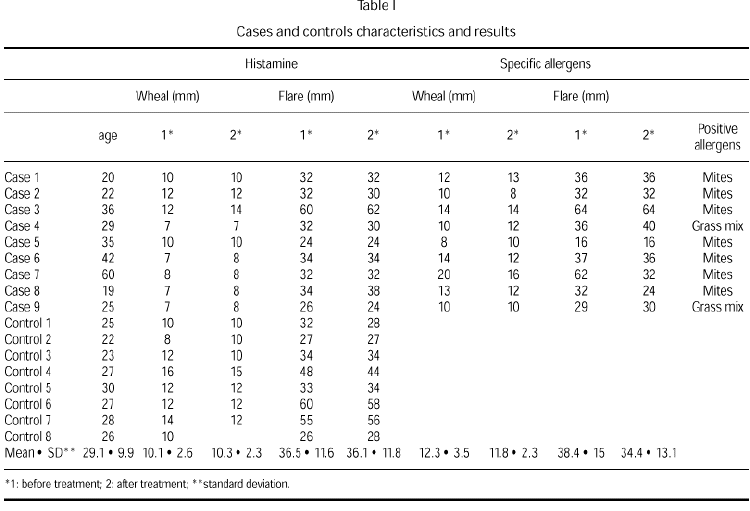INTRODUCTION
It has been shown in many reports that antihistamines, steroids, sedatives, H2 antagonists, beta-2-agonists and theophylline reduce cutaneous reaction against specific allegens (1-3). Consumption of these drugs should be discontinued before skin prick test. But it is not clear that whether anti-leukotriens has to be discontinued or not, before diagnostic skin prick test. The purpose of the present study was to investigate the effects of zafirlukast on cutaneous response to histamine and specific allergens.
MATERIAL AND METHODS
Subjects
Nine patients suffering from allergic mild asthma or allergic rhinitis and eight healthy individuals were recruited to the study. Patients selected from out patient's clinic who were treated with oral zafirlukast 20 mg twice daily and short acting beta-2-agonists when necessary. Skin prick test has been performed routinely for all patients. Healthy individuals were recruited from a volunteers group of our faculty staff and students who do not have any clinically significant medical illness. A medical history, physical examination, chest X ray, electrocardiography, panel for liver and renal functions, complete blood analysis, serology's for hepatitis B and C were used to confirm volunteers' overall good health. We excluded individuals who used anti histamines, theophylline, oral beta-2-agonists and steroids last three weeks (astemizole, last six weeks), who have any prior acute illness in last two-month, chronically health problems other then allergic disease and who did not accept second prick test.
Healthy individuals underwent first skin prick test and than took 20 mg zafirlukast twice daily for 5 days. Each individual underwent second skin prick test after at least 5 days zafirlukast treatment.
Healthy individuals signed an informed consent for participation. Patients underwent second prick test by a mutual confirmation. All test items and healthy individuals drug obtained from commercial source (table I).
Skin prick test
Stallergens' alyostal prick test solutions were used for skin prick test. A drop of histamine hydrochlorur (10 mg/ml) and drops of mould mix, mites, grass mix, eastern trees pollen, dander's pelts were placed on the front arm and a sterile stallerpoint needle used to break the superficial skin through the each drops of solution. After 20 minutes and 60 minutes skin wheal and flare diameter were measured by a ruler.
Statistics
Student t test was performed to compare variables.
RESULTS
Patients and controls characteristics and study results were shown in table I. In both group, cutaneous wheal and flare responds to histamine did not change significantly with zafirlukast (respectively, p = 0.3, p = 0.2). In allergic patients, cutaneous wheal and flare responds to allergens did not also change with zafirlukast (respectively, p = 0.2, p = 0.1). In only one case cutaneous reaction to specific allergen was distinctly diminished with zafirlukast.
DISCUSSION
In this study we have shown that zafirlukast does not affected wheal and flare reaction of skin against to histamine and specific aeroallergens.
In atopic individuals, specific allergen exposure to skin, nasal mucosa, conjunctiva and bronchus result in an immediate IgE mediated mast cell degranulation with release of performed mediators such as histamine as well as newly formed mediators such as cysteinyl leukotriens (4).
These mediators cause wheal and flare reaction in the skin. Histamine is the main mediator of allergic reaction. The role of arachidionic acid metabolites is not clear in allergic skin reaction. However, inhibitors of these metabolites used to determine their role in allergic reactions, in several studies. Atkins et al demonstrated that antagonist of cyclooxygenase metabolites does not inhibit wheal and flare reaction of skin (5). They concluded that cyclooxygenase metabolites are not important in the development of skin inflammatory response in human. Leng and Miura reported that leukotriens are not important role in the allergic reaction of rat skin (6, 7). But Chan et al demonstrated that cysteinyl leukotriens result in wheal and flare raction in human skin, when they are injected intradermally (8). Annila et al recently showed that bee venom induces histamine and leukotriene C4 release in sensitised beekeeper skin (11).
Zafirlukast is a cysteinyl leukotriene 1 receptor antagonist and this type of receptor is found mainly in human bronchus. Zafirlukast in an anti-inflammatory drug, which is shown to reduce airway inflammation after allergen challenge and reduce peripheral eosinophil count. Bernstein and Dahlen reported that zafirlukast inhibit skin wheal and flare reaction against injected cysteinyl leukotriens (10, 11). Dahlen also demonstrated that zafirlukast does not inhibit skin reaction against histamine. We have shown the similar reaction against histamine during zafirlukast treatment.
In early inflammatory response to allergens, cysteinyl leukotriens and histamine are released. Anti-histamines inhibit early skin reaction against allergen (1, 2). But in the study zafirlukast is shown no effect early inflammatory response to allergen in the human skin. Anti-histamines, beta-2-agonists and theophylline reduce early inflammatory response and they should be stopped before diagnostic skin prick test. But zafirlukast does not affect skin reactions against histamine and specific allergens.
We concluded that diagnostic skin prick test can be performed under zafirlukast treatment.






